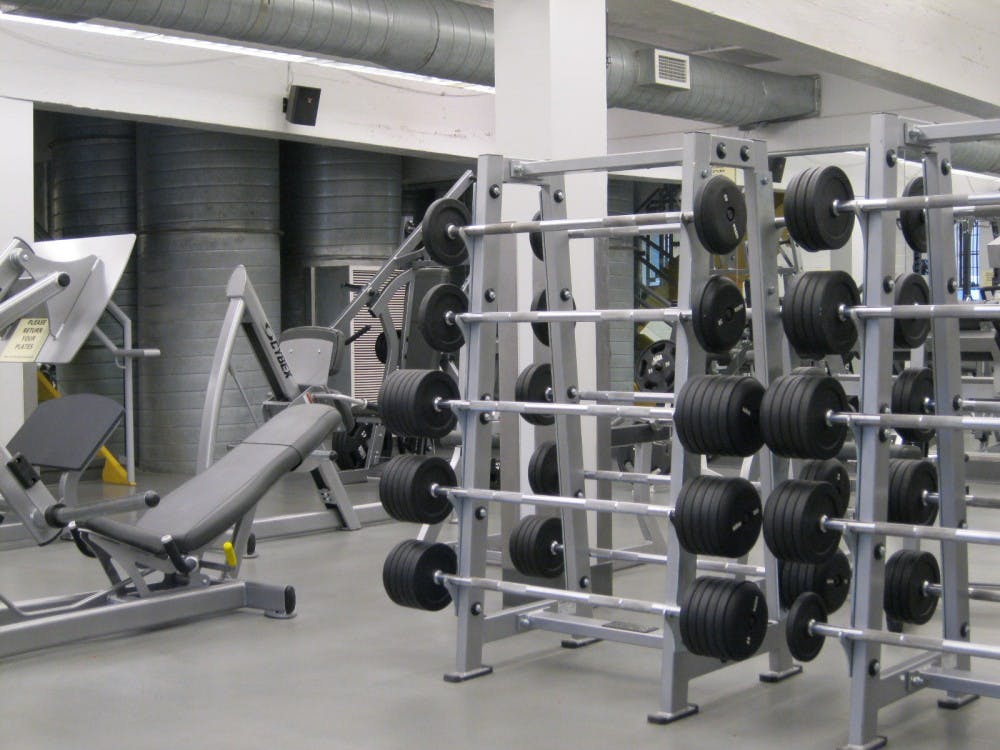Anyone who works out at Stephens Fitness Center knows that men outnumber women in the downstairs area, home to the free weights, squat racks, and bench racks. Of the men and women interviewed for this article, all agreed that men outnumbered women in the weight room.
“Objectively, men outnumber women,” said Allen Welkie GS, who described himself as a frequent gym-goer.
The Daily Princetonian talked to men and women about why this gender disparity persists, despite the well-known benefits of strength conditioning for both genders.
Some women find weight lifting antithetical to their fitness goals.
Sara Lewis ’20, who uses the elliptical and runs, said she hates weight lifting.
“It’s not useful for me. I don’t do heavy lifting,” she said. “I’m not trying to get bulky.”
Ellie Breitfeld ’20, who runs and does abdominal workouts, said she finds the weight room intimidating. She also said that she would be willing to learn how to use weights to improve her arm strength, but she would rather spend her time doing cardio.
Julia Jansen ’19 said she prefers cardio because she does not want to focus on getting bulked up, although she does use weights in about one out of every six workout sessions.

Other women cited lack of experience and an enjoyment of cardio as reasons for choosing not to lift.
For women who do lift, the journey was not easy. When Sarah Drohan GS, the treasurer of the Princeton Powerlifting Club, began lifting three years ago, she felt like she “stood out as the only woman in the room.”
“Eventually, I just stopped caring about it,” she said. Drohan, who studies ecology and evolutionary biology and applied and computational mathematics, said that she often works in male-dominated fields. This phenomenon was quite common among women who lift.
Jean Grossman, a lecturer in the Wilson School, was one of the few female graduate students in the economics department at MIT.

“I’m used to being in an environment that’s almost entirely male, so I think it was easier for me to start doing weights,” she said. Grossman added that when she started lifting 15 years ago, she felt pressure to do only cardio.
“Then I thought, this is as much mine as anyone else’s,” Grossman said.
Chloe Coronado Winn ’19, who is one of the few women studying electrical engineering at the University, said that she first started lifting downstairs when her friend Kathy Zhang ’19 invited her. She added that it’s a “little hard not to notice” the men to women ratio in the weight room. However, she does not think that women should feel intimidated when going to the weight room for the first time.
“If it’s your first time coming down, you feel like, ‘Oh, maybe I don’t know how to use the equipment,’ or, ‘I don’t know what I’m doing,’” Winn said. “But I swear, half the guys here don’t know what they’re doing, so there shouldn’t be anything scary about that.”
Zhang, who majors in classics, took advantage of mentorship opportunities in the weight room. She has previously worked with personal trainers, both in Dillon Gym and back home in Newtown, Pa.
“They showed me how to use everything, which made things easier,” she said.

Photo courtesy of Matthew M. Brzycki.
With time and experience, beginning lifters’ confidence and comfort level in the weight room increases. Although Winn and Zhang lift weights together, both also often go down to the weight room by themselves.
“In order to overcome barriers to entry, it’s important that women are well-represented on a fitness staff,” assistant director of Campus Recreation Matt Brzycki wrote in an email to the ‘Prince.’ “Roughly half of our fitness supervisors and personal trainers are female.”
Brzycki said that misconceptions are sometimes promoted as fact.
“The biggest misconception is that a woman who lifts weights will develop a masculine physique,” he explained. “That — and the unfounded fear that women who lift weights will lose flexibility — is at least partly to blame why women didn’t really start to adopt weight training as a viable form of physical activity until the early 1980s.”
The vast majority of women can significantly increase their muscular strength without an attendant increase in muscular size, according to Brzycki.
He noted that these misconceptions still linger. To that end, Brzycki pointed to Campus Recreation’s extensive array of group fitness classes and a series of introductory classes to help fight these misconceptions, and one of these classes focuses on lifting weights.
Brzycki added that most group fitness classes are designed to accommodate varying levels of ability and experience.
“During the past several years, we’ve offered several workshops in the Stephens Fitness Center that are specifically geared toward weight training for beginners as well as women,” he said. This array of classes has the potential to bring more women into lifting by increasing their familiarity with the sport.
Hope VanCleaf, a communications assistant in the Lewis Center for the Arts, said it was intimidating not to know how to use the free weights.
“I wish they would teach more if you go down there,” she said. VanCleaf said that she only uses free weights at home when she is watching YouTube videos, and added that for most of her life, she did not feel comfortable going to gyms in general.
“The older I have gotten, the more comfortable I have become,” said VanCleaf. “It didn’t matter whether it was men or women [in the room], it was just self-consciousness.”
Bringing more women into the weight room has a host of positive health benefits for new lifters, which women have noted.
Welkie said that women should lift since lifting is a part of any healthy exercise regimen.
“I got my wife into lifting,” he said. “I started lifting before we got married, and then we started lifting together, and she’s actually a personal trainer right now. She’s encouraging other people to lift as well.”
VanCleaf emphasized how important weights are and how her health has improved tenfold since she began to lift. She started lifting to avoid osteoporosis and to strengthen her bones.
Likewise, weight lifting can help women who suffer from depression improve their self-concept. Winn said she feels empowered when she lifts.

Courtesy of Matthew M. Brzycki
From a physical health perspective, lifting weights offers many benefits. Increasing strength improves an individual’s capacity to perform everyday tasks more easily and with greater resistance to fatigue. Weight training also increases lean-body mass and decreases body fat, improving body composition and physical appearance.
“Two percent of American men aged 50 and older have osteoporosis of the hip, while 10 percent of their female counterparts have the same condition which carries a greater risk of fractures,” Brzycki said, citing statistics from the National Center for Health. “Most college students might find that [fact] irrelevant, but it’s never too early to take protective measures to address their bone health in later life.”
Researchers are now finding that weight lifting improves cognitive function, according to Brzycki. “And who doesn’t want that?” he added.








